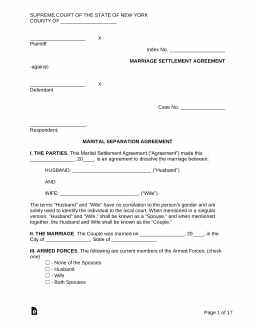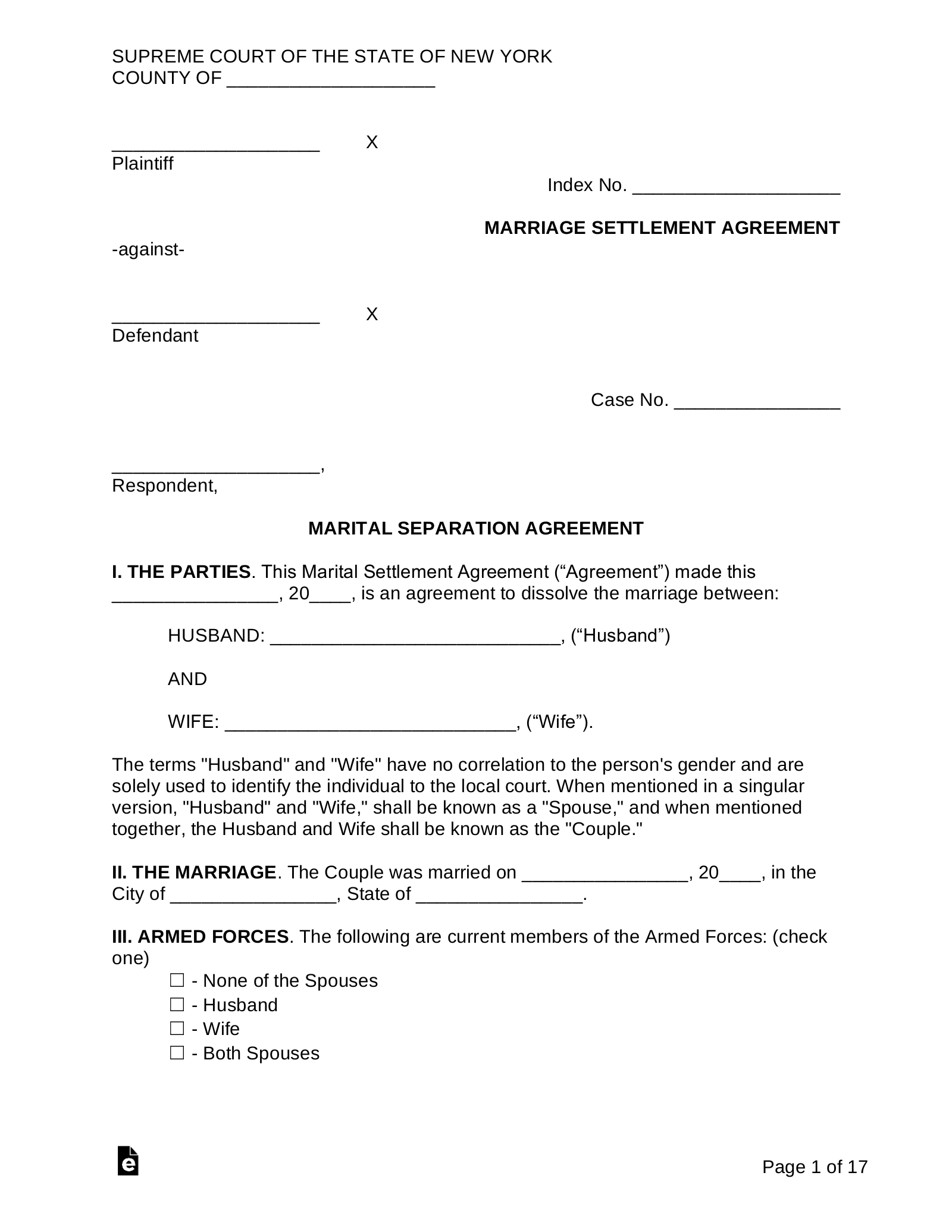Updated August 29, 2023
A New York marital settlement agreement is a divorce tool that helps two spouses come to a mutually beneficial agreement regarding the division of their assets, liabilities, properties, child custody, and child support. Completing a settlement agreement can be done with or without attorneys, but if there are many complicated facets of the marriage, it is recommended that legal counsel be sought. Another option is to bring in a mediator, a neutral third party, to help the spouses maintain organization and civility. Once a marital settlement agreement has been signed by both parties, it becomes legally binding. However, they must still go through the proper divorce proceedings with the supreme court in their county and file all necessary legal documents to obtain an official judgment of divorce from a judge.
Table of Contents |
Divorce Laws
Statutes – Domestic Relations, Articles 9 through 13
Alimony (§ 236 Part B (6)) – The court will consider the following factors while calculating the amount of alimony (referred to as “post-divorce maintenance” in New York) that the spouse with the higher income (payor) must pay to the spouse with the lower income (payee) after a divorce decree:
- Age and health
- Earning capacity (present and future)
- Ability to become self-supporting (of payee)
- Termination of child support
- Wasteful dissipation of marital property
- Pre-marital joint household and pre-divorce separate household
- Actions inhibiting a party’s earning capacity or ability to obtain employment
- Medical insurance
- Care of children and stepchildren (minor or disabled adult), and elderly parents or in-laws
- Tax consequences
- Standard of living established during the marriage
- Missed opportunity to establish earning capacity due to marriage (of payee)
- Equitable distribution of property and income generated therefrom
- Contributions and services as a spouse, parent, wage earner, and homemaker (of payee)
- Any other factors deemed pertinent by the court
Alimony Calculator – NYCourts.gov
Child Support (§ 240(1-b)) – The court will use the income shares model to determine child support payments. The combined income of the parents (regardless of income level) will be used, and a percentage of that income (based on the number of children under twenty-one) will be allocated to child support.
Child Support Calculator – NYC Human Resources Administration
Division of Property (§ 236 Part B (5)) – The distribution of property to the spouses in a divorce judgment is determined by a number of factors to ensure both parties obtain their fair share of the properties. This is known as the equitable distribution law.
Grounds for Divorce (§ 170) – An action for divorce can be attained by filing for one of the following reasons:
- Cruel and inhuman treatment
- Abandonment for one (1) or more years
- Imprisonment of either spouse for three (3) or more consecutive years
- Adultery
- Separation for one (1) or more years (either by judge’s decree or written agreement of separation)
- Irretrievable breakdown of the marriage
Interim Support (§ 236 Part B (5-a)) – The spouse with the lower income shall receive from the other spouse interim support (referred to as “temporary maintenance”) for the duration of the divorce proceedings.
Residency (§ 230) – At least one spouse must be living in the state of New York for one (1) year prior to filing for divorce in the state. However, if the couple was not married in the state or have not resided together in the state as husband and wife, one spouse must be a resident of the state at least two (2) years prior to filing for divorce.
Separation (§ 200) – Separation is not a requirement for a divorce action to be filed or a divorce decree to be ordered by a judge; however, a couple may choose to file for legal separation on any of the reasons mentioned in grounds for divorce.
Divorce Forms
- Where to File – New York Supreme Court
- Filing Fee – $210 (plus $125 for Note of Issue)
- How Long Does it Take? Six (6) to twelve (12) weeks
Uncontested Divorce with No Children:
- Notice of Automatic Orders
- Notice of Guideline Maintenance
- Notice Concerning Continuation of Health Care Coverage
- Summons with Notice (Form UD-1) OR Summons (Form UD-1a) and Verified Complaint (Form UD-2)
- Affidavit of Service (Form UD-3)
- Sworn Statement of Removal of Barriers to Remarriage (Form UD-4)
- Affirmation of Regularity (Form UD-5)
- Affidavit of Plaintiff (Form UD-6)
- Affidavit of Defendant (Form UD-7)
- Annual Income Worksheet (Form UD-8(1))
- Maintenance Guidelines Worksheet (Form UD-8(2))
- Note of Issue (Form UD-9)
- Findings of Fact/Conclusions of Law (Form UD-10)
- Judgment of Divorce (Form UD-11)
- Part 130 Certification (UD-12)
- Request for Judicial Intervention (Form UD-13)
- Notice of Entry (Form UD-14)
- Certificate of Dissolution of Marriage
Uncontested Divorce With Children:
- Notice of Automatic Orders
- Notice of Guideline Maintenance
- Notice Concerning Continuation of Health Care Coverage
- Summons with Notice (Form UD-1) OR Summons (Form UD-1a) and Verified Complaint (Form UD-2)
- Affidavit of Service (Form UD-3)
- Sworn Statement of Removal of Barriers to Remarriage (Form UD-4)
- Affirmation of Regularity (Form UD-5)
- Affidavit of Plaintiff (Form UD-6)
- Affidavit of Defendant (Form UD-7)
- Annual Income Worksheet (Form UD-8(1))
- Maintenance Guidelines Worksheet (Form UD-8(2))
- Child Support Worksheet (Form UD-8(3))
- Support Collection Unit Information Sheet (Form UD-8a)
- Qualified Medical Child Support Order (Form UD-8b)
- Note of Issue (Form UD-9)
- Findings of Fact/Conclusions of Law (Form UD-10)
- Judgment of Divorce (Form UD-11)
- Part 130 Certification (UD-12)
- Request for Judicial Intervention (Form UD-13) and Addendum (Form 840M)
- Notice of Entry (Form UD-14)
- Certificate of Dissolution of Marriage
- Child Support Summary Form (Form UCS-111)
How to File for Divorce in New York (5 steps)
- Prepare and File Forms
- Serve Defendant
- Failure to Return Affidavit (If Applicable)
- Note of Issue
- Judgment of Divorce
1. Prepare and File Forms

Filing an uncontested divorce in the state of New York will be quicker and less expensive than a contested divorce, but there are still a lot of forms to fill out and a number of steps to complete before a divorce can be finalized. To begin an uncontested divorce case, one spouse (who will be named the “plaintiff”) will have to complete a Summons with Notice (Form UD-1) OR a Summons (Form UD-1a) and Verified Complaint (Form UD-2). These forms should be filed with the court clerk at the supreme court in the county in which one of the spouses is a resident (see residency rules). It’s possible that the clerk will provide an Index Number Application Form for the plaintiff to fill out as well. A fee of $210 will be charged for filing all forms, and an index number will be assigned to the case by the clerk.
2. Serve Defendant
 In a divorce case, the non-filing party automatically becomes the defendant for the purposes of the proceedings. The plaintiff must deliver the Summons (Form UD-1 OR Forms UD-1a and UD-2), a Notice of Automatic Orders, a Notice of Guidelines Maintenance, a Notice Concerning Continuation of Health Care Coverage, and an Affidavit of Defendant (Form UD-7) to the defendant. If the divorce involves children under the age of twenty-one (21), a Child Support Standards Chart must be delivered to the defendant as well. If the marriage was initiated through a religious ceremony, the defendant must complete and serve a copy of the Sworn Statement of Removal of Barriers to Remarriage (Form UD-4). The Affidavit of Defendant must be completed and returned to the plaintiff before the divorce case is entered into the court calendar. This document is the defendant’s way of showing they do not contest the divorce. If they do not return the signed Affidavit in time, the plaintiff must follow Step 3, otherwise, they will continue to Step 4.
In a divorce case, the non-filing party automatically becomes the defendant for the purposes of the proceedings. The plaintiff must deliver the Summons (Form UD-1 OR Forms UD-1a and UD-2), a Notice of Automatic Orders, a Notice of Guidelines Maintenance, a Notice Concerning Continuation of Health Care Coverage, and an Affidavit of Defendant (Form UD-7) to the defendant. If the divorce involves children under the age of twenty-one (21), a Child Support Standards Chart must be delivered to the defendant as well. If the marriage was initiated through a religious ceremony, the defendant must complete and serve a copy of the Sworn Statement of Removal of Barriers to Remarriage (Form UD-4). The Affidavit of Defendant must be completed and returned to the plaintiff before the divorce case is entered into the court calendar. This document is the defendant’s way of showing they do not contest the divorce. If they do not return the signed Affidavit in time, the plaintiff must follow Step 3, otherwise, they will continue to Step 4.
3. Failure to Return Affidavit (If Applicable)
 If the defendant does not sign and return the Affidavit, a process server must be hired by the plaintiff to serve the defendant with the forms a second time. The appropriate Summons form(s), the Notice of Automatic Orders, the Notice of Guidelines Maintenance, the Affidavit of Defendant (Form UD-7), the Child Support Standards Chart (if applicable), and a Notice Concerning Continuation of Health Care Coverage must be served on the defendant. The server must complete the Affidavit of Service (Form UD-3), which will be filed with the rest of the documents when the case is entered into the court calendar. There are three (3) outcomes following service on the defendant. If the defendant signs and returns the Affidavit of Defendant, the divorce is uncontested and the case can be entered into the court calendar right away (Step 4). If the defendant does not sign and return the Affidavit, the defendant is in default, but it’s still an uncontested divorce. This means the plaintiff must wait forty (40) days to input the case into the court calendar (Step 4). The third outcome occurs when the defendant files a notice of appearance, which means the case is contested and the divorce proceedings will be more complicated, timely, and expensive (legal counsel should be sought).
If the defendant does not sign and return the Affidavit, a process server must be hired by the plaintiff to serve the defendant with the forms a second time. The appropriate Summons form(s), the Notice of Automatic Orders, the Notice of Guidelines Maintenance, the Affidavit of Defendant (Form UD-7), the Child Support Standards Chart (if applicable), and a Notice Concerning Continuation of Health Care Coverage must be served on the defendant. The server must complete the Affidavit of Service (Form UD-3), which will be filed with the rest of the documents when the case is entered into the court calendar. There are three (3) outcomes following service on the defendant. If the defendant signs and returns the Affidavit of Defendant, the divorce is uncontested and the case can be entered into the court calendar right away (Step 4). If the defendant does not sign and return the Affidavit, the defendant is in default, but it’s still an uncontested divorce. This means the plaintiff must wait forty (40) days to input the case into the court calendar (Step 4). The third outcome occurs when the defendant files a notice of appearance, which means the case is contested and the divorce proceedings will be more complicated, timely, and expensive (legal counsel should be sought).
4. Note of Issue
 When the defendant has signed and returned the Affidavit, or the 40-day period has come to an end due to the defendant’s default, the case can be put into the court calendar. The plaintiff must complete and file the following forms with the court clerk:
When the defendant has signed and returned the Affidavit, or the 40-day period has come to an end due to the defendant’s default, the case can be put into the court calendar. The plaintiff must complete and file the following forms with the court clerk:
- Affidavit of Service (Form UD-3) (completed by process server)
- Sworn Statement of Removal of Barriers to Remarriage (Form UD-4) (only applicable if wedding was a religious ceremony)
- Affirmation of Regularity (Form UD-5)
- Affidavit of Plaintiff (Form UD-6)
- Affidavit of Defendant (Form UD-7) (only if already signed by the defendant)
- Annual Income Worksheet (Form UD-8(1)) (only if either party seeks maintenance or child support)
- Maintenance Guidelines Worksheet (Form UD-8(2)) (only if payee is seeking maintenance)
- Child Support Forms (only if there are unemancipated children of the marriage):
- Note of Issue (Form UD-9)
- Findings of Fact/Conclusions of Law (Form UD-10)
- Judgment of Divorce (Form UD-11)*
- Part 130 Certification (UD-12)
- Request for Judicial Intervention (Form UD-13) and Addendum (Form 840M) (addendum need only be completed if there are minor children)
- Notice of Entry (Form UD-14)
- Certificate of Dissolution of Marriage
- Child Support Summary Form (Form UCS-111)
- Self-addressed and stamped postcard (example)
When filing, the plaintiff should include copies of all the original documents they initially filed with the clerk (summons, notices, etc.). The filing fee is $125 for the Note of Issue plus an additional fee for the Request for Judicial Intervention, which will vary by county.
*Note: Sections 35 and 36 of the Judgment of Divorce form allow either party to revert to their maiden name. A request to resume one’s former name is always accepted by the judge, and making the request during the divorce proceedings instead of after could save the spouse(es) time and money to change it later.
5. Judgment of Divorce
 Once all the papers are filed, the judge that has been assigned to the case will review them to ensure everything is in order. The judge may wish to call a hearing even if both parties seem to be in agreement, especially in cases involving alimony, custody, visitation, or distribution of property. If the judge is satisfied with everything presented to them, they will sign the Judgment of Divorce (Form UD-11).
Once all the papers are filed, the judge that has been assigned to the case will review them to ensure everything is in order. The judge may wish to call a hearing even if both parties seem to be in agreement, especially in cases involving alimony, custody, visitation, or distribution of property. If the judge is satisfied with everything presented to them, they will sign the Judgment of Divorce (Form UD-11).


